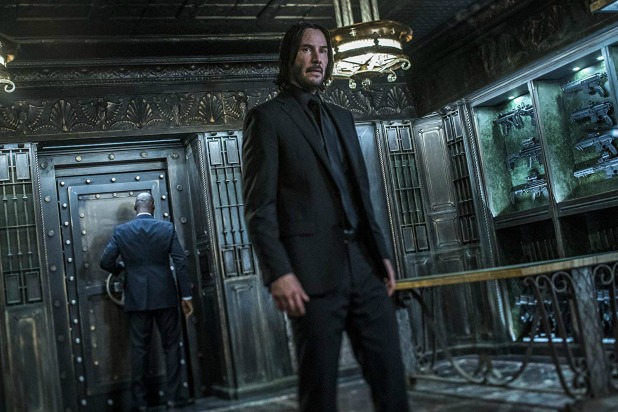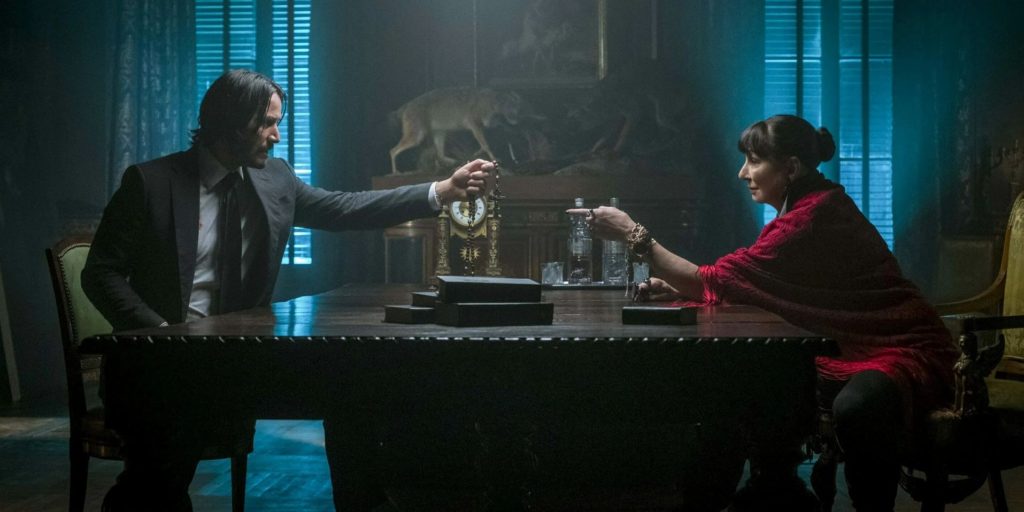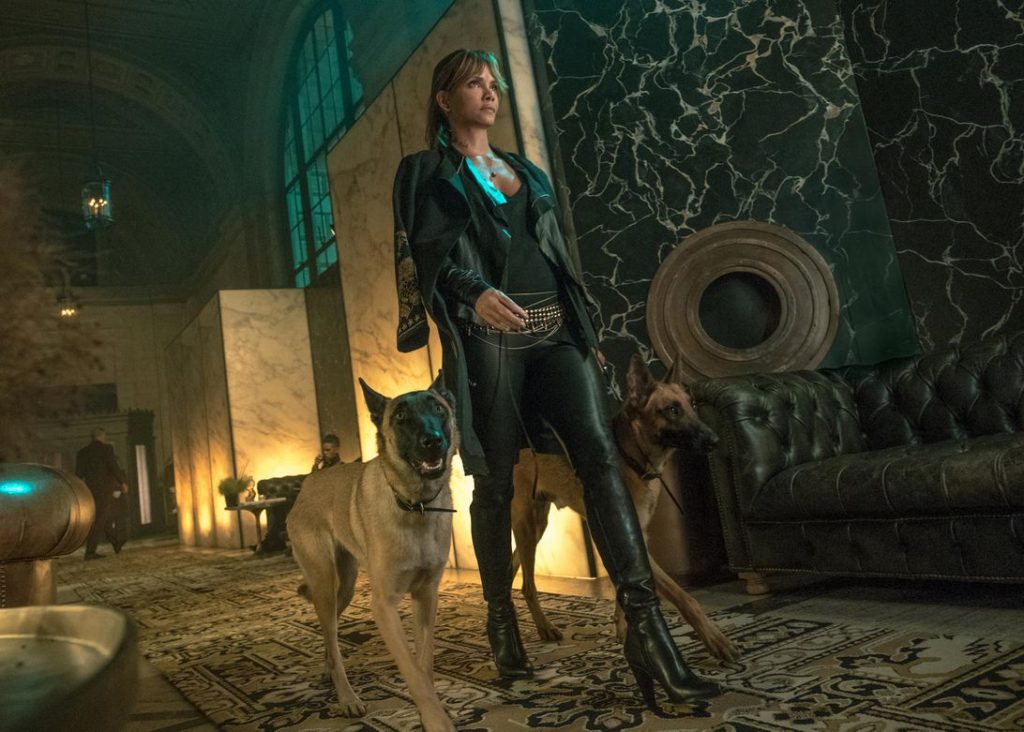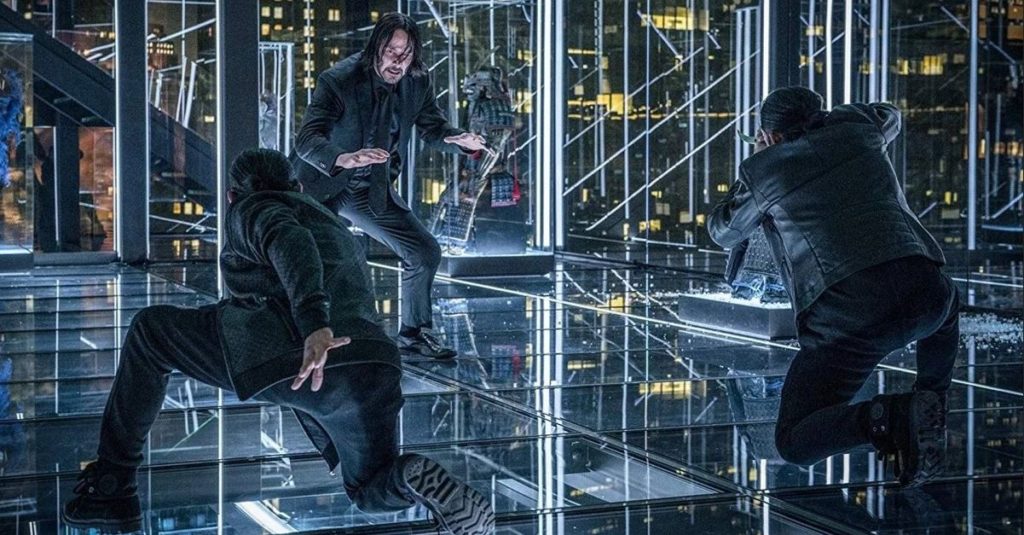
John Wick isn’t picky. He will kill you with a gun, a knife, a car, a dog, a horse, a library book—the particular weapon doesn’t matter, because he is the weapon. He’s a man who is also a murder machine, precisely calibrated to dispense death as proficiently as possible. There is no malice in his lethality, just as there is no malice when an elephant steps on an insect. He does not kill you because he dislikes you; he kills you because you are in his way.
John Wick: Parabellum, the third chapter in this insane and gloriously operatic franchise, is not quite as efficient as its bearded and besuited namesake. It occasionally suffers from bloat and drag, and it doesn’t always move with absolute purpose. For the most part, though, this is another action triumph, a grand and propulsive movie that understands what it is and what it’s good at. And even when its ostentatious trappings occasionally disappoint, its primal heart keeps beating.
That heart, of course, belongs to Keanu Reeves, now 54 years old and a good quarter-century removed from barreling down the streets of Los Angeles on a runaway bus. The John Wick films are so aggressively stylized, it’s easy to overlook the unglamorous intensity of their star, the way he inhabits his grim assassin without a trace of irony. He’s hardly the most athletic martial artist in the world, but there’s a decisiveness to his movements that gives his blunt physicality a certain grace. He also makes sweaty meals out of the simplest dialogue; not since Clint Eastwood in Unforgiven has anyone growled “Yeah” with such ferocity.

When we last left cinema’s deadliest dog-lover, he was declared “excommunicado”, meaning he was a marked man, stripped of the many privileges that this ornately detailed underworld had afforded him. That’s bad news for John, because seemingly every bounty hunter in the world is now gunning for him, but it’s good news for us, for precisely the same reason. Perhaps I’m falling prey to the series’ hyperbolic spirit, but the first 20 or so minutes of Parabellum, which feature John fending off three different attempts on his life, represent some of the most exhilarating action filmmaking of the new millennium. Director Chad Stahelski stages these fights with consistent vigor, placing premiums on speed and savagery—the crunch of snapping bone is heard again and again—but never sacrificing visual coherence. Yet he also brings variety to the violence, so that each separate skirmish—an impromptu duel in a library against a hulking giant (Boban Marjanović!), where John turns a tome of Russian literature into an instrument of death; a melee in a museum, where antique weapons are resurrected to lethal life; a breathless chase down Manhattan’s streets, where John demolishes his enemies while riding a god damn horse—carries its own specific thrill. Even as the bodies hit the floor over and over, there isn’t a hint of repetition.
Not at first, anyway. As a threequel, Parabellum faces a familiar challenge: It must both conform to its predecessors and also continually one-up them. In the John Wick universe, that means more than just constructing action sequences with escalating élan; it also requires further developing the rich mythology that the first film laid out convincingly, and which the second chapter expanded with magnificent flair. Yet at times, Parabellum suggests that the ceiling for this concept may have already been struck. There are some intriguing new faces played by talented actors; Jerome Flynn (Bronn on Game of Thrones) and Saïd Taghmaoui show up as haughty power brokers of sorts, while a very good Asia Kate Dillon (Billions), portraying an imperious figure known only as The Adjudicator, sweeps into town cloaked in black fabric and mystique. (Halle Berry, for her part, is rather stiff as one of John’s past associates with a pair of exceedingly well-trained Belgian Malinois.) But much of the world-building—a crucifix necklace freighted with historical significance, a hotel being classified as “deconsecrated”, lots of ominous chatter about “The Elder” and “The High Table”—feels secondhand, like new spins on a previously established mythos rather than genuinely fresh ideas.

Yet even if Parabellum lacks the revolutionary splendor of John Wick: Chapter 2, it remains an accomplished and often dazzling piece of cinema, layering one showstopping sequence on top of the next. In a way, the movie is structured like a classic videogame; its hero must progress through a series of increasingly difficult levels, leading up to a climactic face-off against the big boss. This creates an obvious risk of diminishing returns, but Stahelski mostly avoids the trap, thanks to steady framing and eye-catching production design. Large chunks of the action take place at the famous New York Continental, that haven for assassins where no blood may be spilled, and which in this installment has been transformed into a palace of glass and neon. Throughout, Stahelski makes playful use of windows and mirrors; characters often stare one another down while separated by thick panes, while combatants regularly appear as reflections only to suddenly vanish like smoke.
The Continental’s opulence plays into Parabellum’s overall tone of gleeful absurdity, which is further augmented by the stellar supporting cast, including a delightfully profane Laurence Fishburne as a pigeon-keeping shambolic warlord and a wonderfully blithe Ian McShane as the hotel’s nonchalant proprietor. Their sly insouciance adds lightness to this buoyant movie, which is grounded just enough by Reeves’s rigid commitment. As a character, John Wick’s legend is so immense, even his enemies are honored to share the field of battle with him; in one electric sequence, two of his foes—portrayed by Cecep Arif Rahman and Yayan Ruhian, gifted martial artists who appeared in the Raid films—interrupt the fight simply to shake their opponent’s hand. Yet while Parabellum never takes itself too seriously, Reeves plays it completely straight, refusing to crack a smile even when he’s quoting The Matrix and asking for guns, lots of guns.
Too many, it turns out. The majority of Parabellum’s set pieces are giddily kinetic, but a handful of lengthy gun battles, particularly one set in Casablanca, eventually grow tedious. By this point in the franchise, John’s body count has surely approached the thousands, and there are only so many interesting ways for him to shoot another goon in the head.

Thankfully, these are the exceptions, as Stahelski has conceived of no shortage of methods for John to practice his mortal craft. These include a motorcycle chase, where blades and bullets slice through tires and limbs, and several other swordfights, which reinforce the axiom that an action movie’s quality is directly correlated to the volume of its swordplay. If the plot of Parabellum resembles a videogame, its individual sequences often feel like musical numbers, Stahelski choreographing elaborate dances of inventive mayhem that practically demand applause from its awestruck audience.
Following an especially bruising and bloody brawl, a bald mercenary named Zero—one of the film’s chief villains, ably played by Mark Dacascos, whose own magnum martial arts opus, Only the Strong, came out the year before Speed—pauses to catch his breath. “That was a pretty good fight, huh?” he asks, a rhetorical question that downplays the elegant brutality of what you just witnessed; Parabellum’s fights are far better than pretty good. And if its ending is somewhat unsatisfying, that’s because the John Wick movies aren’t really designed to end; they’re perpetual motion machines, constantly assaulting their protagonist with one fearsome threat after another. Three features and countless kills in, our battered hero has probably earned himself a break. But do I selfishly hope that he’ll keep coming back, dispatching foolish foes with immaculate fury? That’s another rhetorical question, but I’ll adopt John’s brusque vocabulary and answer it anyway. In other words: yeah.
Grade: B
Jeremy Beck is the editor-in-chief of MovieManifesto. He watches more movies and television than he probably should.
